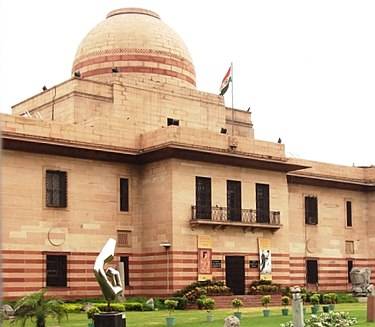Selected artworks from the post-Independence era that offer a glimpse into Indias contemporary art have been put up on view at the National Gallery of Modern Art (NGMA) in the national capital.
Coming from the NGMA gallery’s in-house collection which was in the reserve for about a year and a half, the works represent few milestones in the art landscape from the post-freedom era. On view are around 60 works, including paintings, sculptures and prints.

“This is the time which witnessed the formation of various artist collectives named after the urban centre of their origin. These centres represented by their artists produced an artistic language that was a synthesis of traditional Indian art with the international artistic trends such as impressionism and expressionism,” the NGMA said.
The monumental canvas on display, titled ‘Zamin’ by artist M.F. Husain portrays the relationship of the famer with the soil he tills, in an abstract and angular style which will formulate his signature way of expression in his future works.
The triptych popularly called ‘Shantiniketan’ by Tyeb Mehta, also takes a folk event of sacrifice that took place during his stay in Shantiniketan, to form his own allegory of life.
The emancipation of women was always central theme of many women artists of this period, a voice that became stronger than ever before. It all started from an echo which can be traced back to the paintings of Amrita Sher-Gil, where the melancholy of the indecisiveness about the near future reflected in the eyes of the women that took centre stage on her canvases could be seen.
Now, the woman from this submissive and tragic victim portrayed in many artworks, is elevated and celebrated as a supreme power, reflected in the works of Arpana Caur and Anjolie Ela Menon. Arpana Caur is one of the first artists, who collaborated with indigenous folk artisans of Warli to successfully transform her visions into her paintings.
With a different approach, sculptor Latika Katt, uses a traditional imagery of the burnt remains of a funeral pyre, titled, ‘Arthi’, to evoke the feeling of ‘memento mori’ inside the viewer.
Abstraction was also a major form of expression adopted by many artists. The exhibition also highlights this form of expression through the pin-point textures of Zarina Hashmi and the high relief metal sculpture of Himmat Shah.
The evolution of art in the 1990’s in India, took a new road map with artists experimenting with newer materials often mixing different mediums, further blurring the boundaries between sculpture, painting, design and performing arts.
In the works of Jitish Kallat and Subodh Gupta, one sees their experiences through their themes and metaphors which can be identified and related to universally.
The exhibition has been put up in the basement area of the permanent display section in NGMA’s New Wing.
By Siddhi Jain
https://www.daijiworld.com/news/newsDisplay.aspx?newsID=675957
Selected artworks from the post-Independence era that offer a glimpse into contemporary Indian art are currently showcased at the National Gallery of Modern Art (NGMA) in the national capital. Sourced from NGMA’s in-house collection after being reserved for about a year and a half, these works depict significant milestones in the art landscape of that time. The exhibition presents around 60 pieces, including paintings, sculptures, and prints, reflecting the transformative shift of artistic expression from rural to urban spaces following India’s independence in 1947.
